Tesco's Value Chain Model: Business Operations and Internal Analysis
VerifiedAdded on 2023/01/16
|8
|2506
|89
Essay
AI Summary
This essay provides a comprehensive value chain analysis of Tesco, a major retail company. It begins with an introduction to the value chain model, explaining its importance for optimizing efficiency and maintaining demand and supply. The essay then delves into Tesco's business operations, highlighting its global presence and market position. The core of the analysis examines Tesco's internal environment through Porter's value chain model, detailing primary activities such as inbound and outbound logistics, operations, marketing and sales, and services, as well as secondary activities including procurement, HRM, technological development, and infrastructure. The analysis explores the significance of each activity and their impact on Tesco's success. The essay concludes with reflections and recommendations, suggesting strategies to enhance Tesco's performance, such as leveraging technology, improving supplier relationships, and implementing effective marketing campaigns. The essay emphasizes the importance of a well-managed value chain for Tesco's competitiveness and growth.
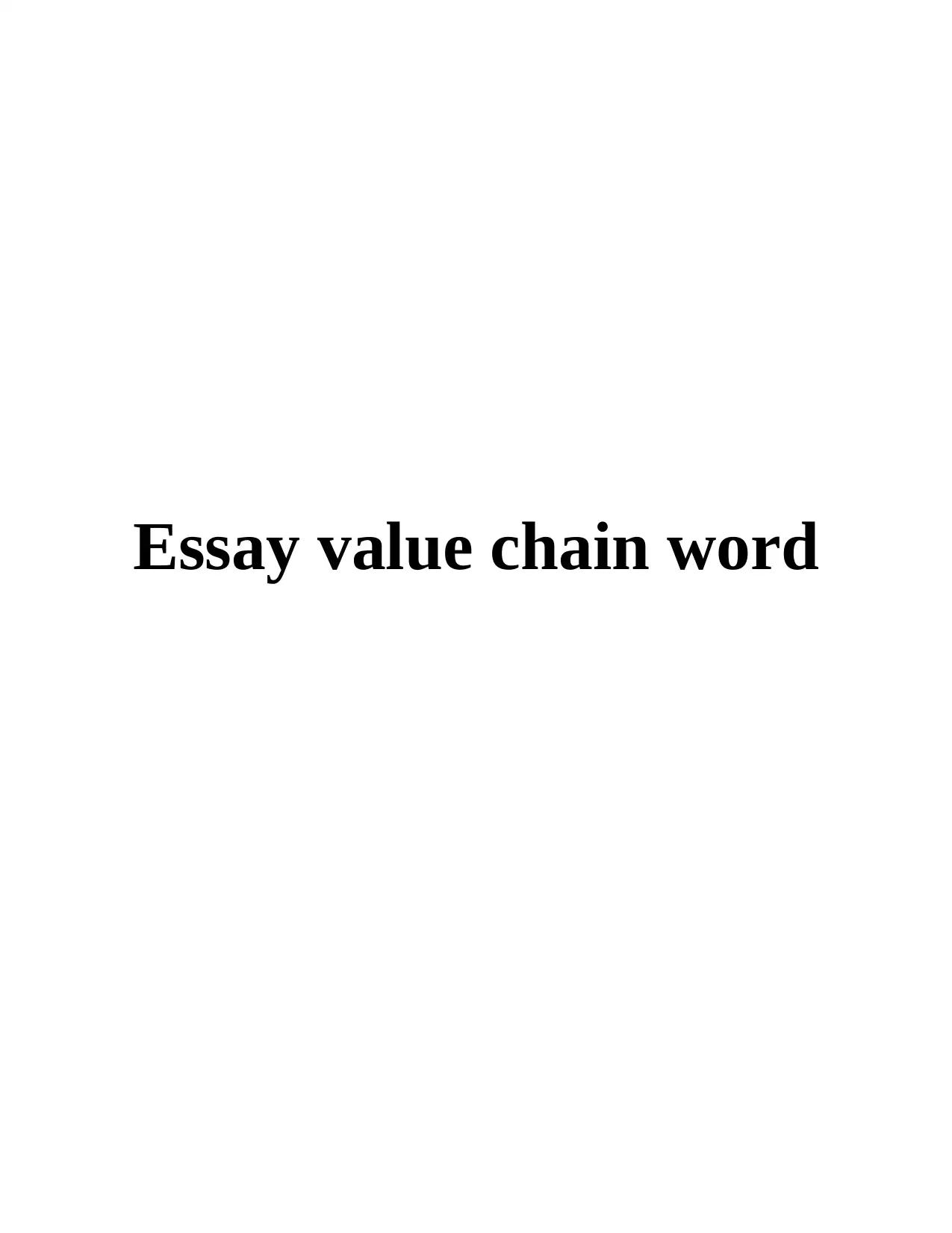
Essay value chain word
Paraphrase This Document
Need a fresh take? Get an instant paraphrase of this document with our AI Paraphraser
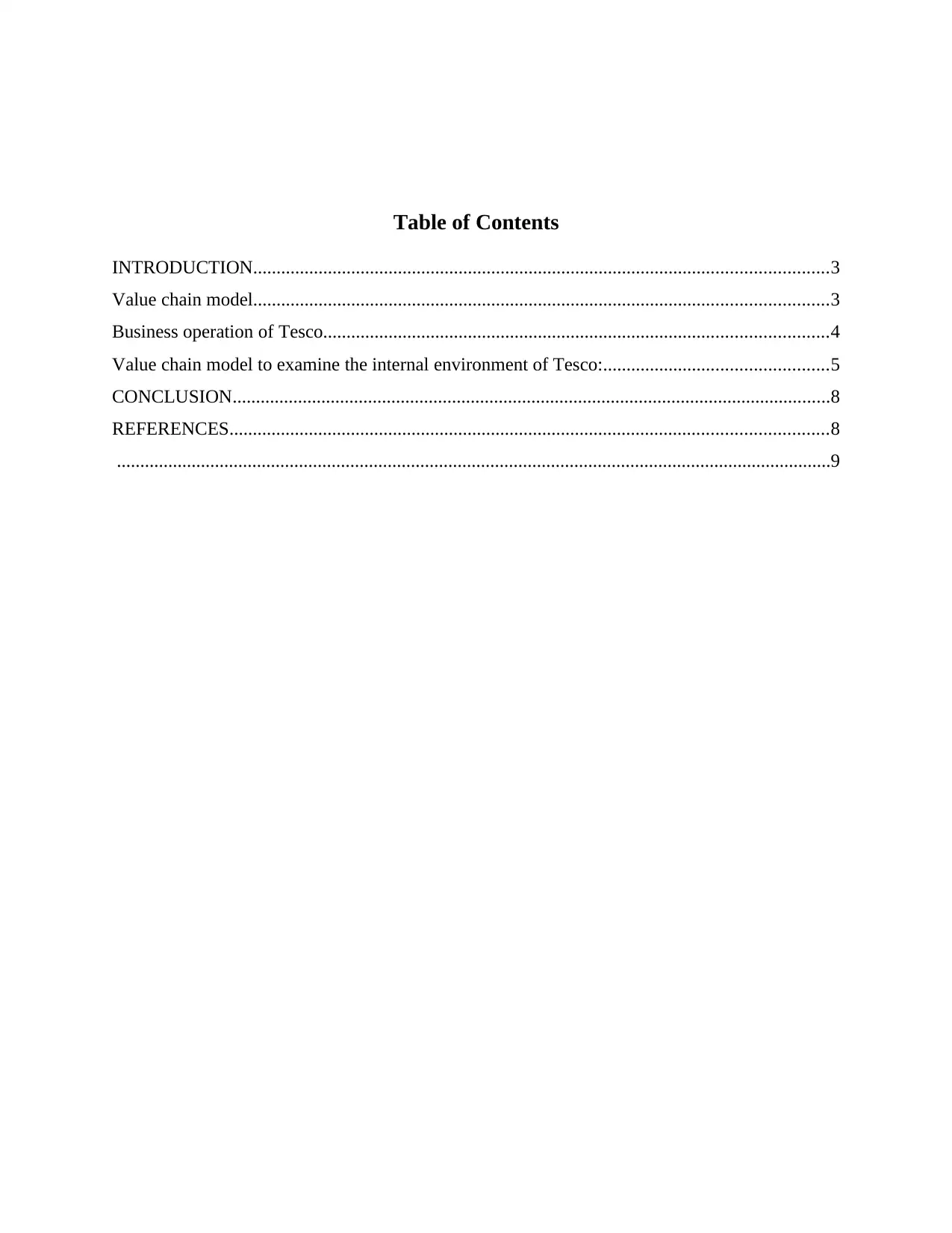
Table of Contents
INTRODUCTION...........................................................................................................................3
Value chain model...........................................................................................................................3
Business operation of Tesco............................................................................................................4
Value chain model to examine the internal environment of Tesco:................................................5
CONCLUSION................................................................................................................................8
REFERENCES................................................................................................................................8
.........................................................................................................................................................9
INTRODUCTION...........................................................................................................................3
Value chain model...........................................................................................................................3
Business operation of Tesco............................................................................................................4
Value chain model to examine the internal environment of Tesco:................................................5
CONCLUSION................................................................................................................................8
REFERENCES................................................................................................................................8
.........................................................................................................................................................9
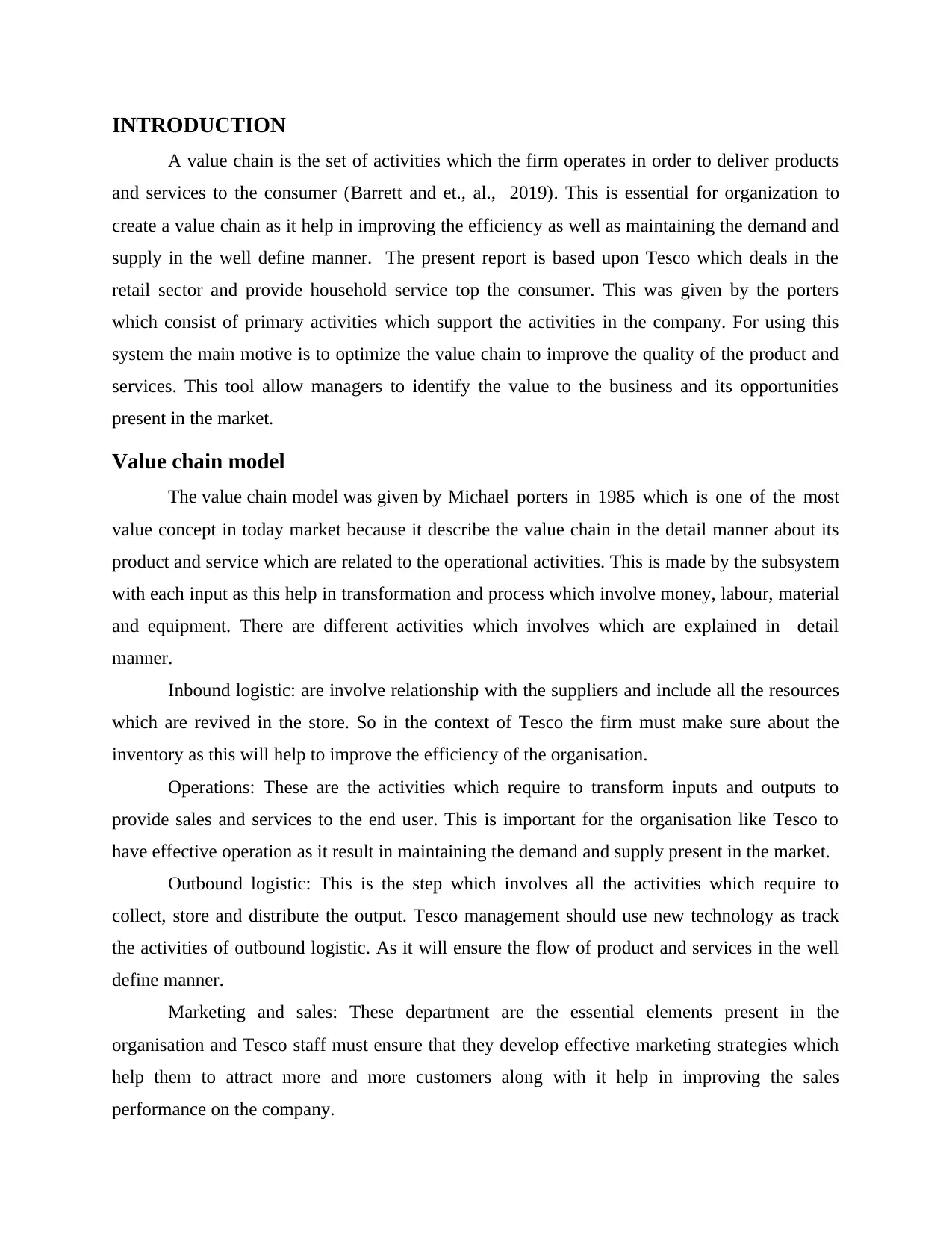
INTRODUCTION
A value chain is the set of activities which the firm operates in order to deliver products
and services to the consumer (Barrett and et., al., 2019). This is essential for organization to
create a value chain as it help in improving the efficiency as well as maintaining the demand and
supply in the well define manner. The present report is based upon Tesco which deals in the
retail sector and provide household service top the consumer. This was given by the porters
which consist of primary activities which support the activities in the company. For using this
system the main motive is to optimize the value chain to improve the quality of the product and
services. This tool allow managers to identify the value to the business and its opportunities
present in the market.
Value chain model
The value chain model was given by Michael porters in 1985 which is one of the most
value concept in today market because it describe the value chain in the detail manner about its
product and service which are related to the operational activities. This is made by the subsystem
with each input as this help in transformation and process which involve money, labour, material
and equipment. There are different activities which involves which are explained in detail
manner.
Inbound logistic: are involve relationship with the suppliers and include all the resources
which are revived in the store. So in the context of Tesco the firm must make sure about the
inventory as this will help to improve the efficiency of the organisation.
Operations: These are the activities which require to transform inputs and outputs to
provide sales and services to the end user. This is important for the organisation like Tesco to
have effective operation as it result in maintaining the demand and supply present in the market.
Outbound logistic: This is the step which involves all the activities which require to
collect, store and distribute the output. Tesco management should use new technology as track
the activities of outbound logistic. As it will ensure the flow of product and services in the well
define manner.
Marketing and sales: These department are the essential elements present in the
organisation and Tesco staff must ensure that they develop effective marketing strategies which
help them to attract more and more customers along with it help in improving the sales
performance on the company.
A value chain is the set of activities which the firm operates in order to deliver products
and services to the consumer (Barrett and et., al., 2019). This is essential for organization to
create a value chain as it help in improving the efficiency as well as maintaining the demand and
supply in the well define manner. The present report is based upon Tesco which deals in the
retail sector and provide household service top the consumer. This was given by the porters
which consist of primary activities which support the activities in the company. For using this
system the main motive is to optimize the value chain to improve the quality of the product and
services. This tool allow managers to identify the value to the business and its opportunities
present in the market.
Value chain model
The value chain model was given by Michael porters in 1985 which is one of the most
value concept in today market because it describe the value chain in the detail manner about its
product and service which are related to the operational activities. This is made by the subsystem
with each input as this help in transformation and process which involve money, labour, material
and equipment. There are different activities which involves which are explained in detail
manner.
Inbound logistic: are involve relationship with the suppliers and include all the resources
which are revived in the store. So in the context of Tesco the firm must make sure about the
inventory as this will help to improve the efficiency of the organisation.
Operations: These are the activities which require to transform inputs and outputs to
provide sales and services to the end user. This is important for the organisation like Tesco to
have effective operation as it result in maintaining the demand and supply present in the market.
Outbound logistic: This is the step which involves all the activities which require to
collect, store and distribute the output. Tesco management should use new technology as track
the activities of outbound logistic. As it will ensure the flow of product and services in the well
define manner.
Marketing and sales: These department are the essential elements present in the
organisation and Tesco staff must ensure that they develop effective marketing strategies which
help them to attract more and more customers along with it help in improving the sales
performance on the company.
⊘ This is a preview!⊘
Do you want full access?
Subscribe today to unlock all pages.

Trusted by 1+ million students worldwide
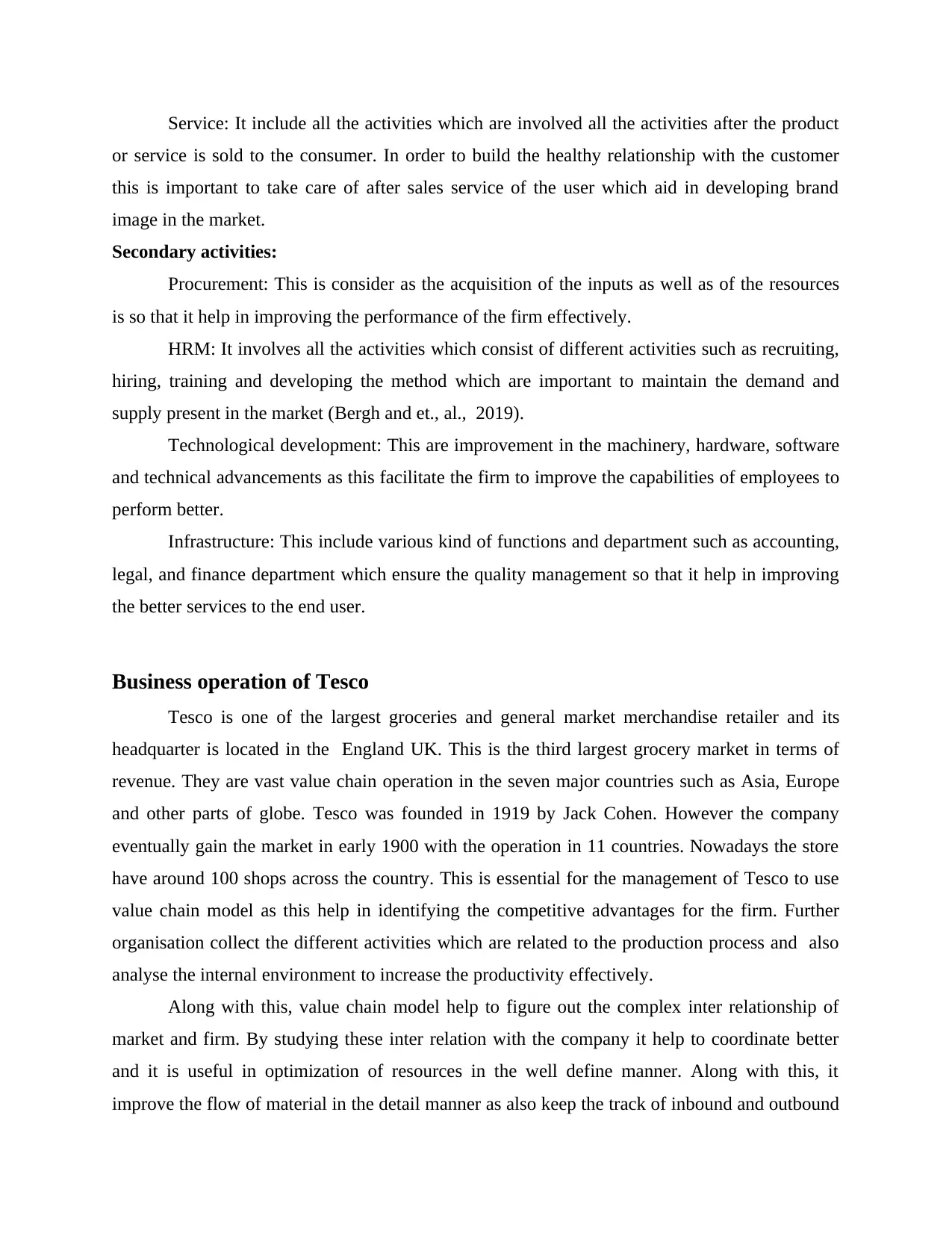
Service: It include all the activities which are involved all the activities after the product
or service is sold to the consumer. In order to build the healthy relationship with the customer
this is important to take care of after sales service of the user which aid in developing brand
image in the market.
Secondary activities:
Procurement: This is consider as the acquisition of the inputs as well as of the resources
is so that it help in improving the performance of the firm effectively.
HRM: It involves all the activities which consist of different activities such as recruiting,
hiring, training and developing the method which are important to maintain the demand and
supply present in the market (Bergh and et., al., 2019).
Technological development: This are improvement in the machinery, hardware, software
and technical advancements as this facilitate the firm to improve the capabilities of employees to
perform better.
Infrastructure: This include various kind of functions and department such as accounting,
legal, and finance department which ensure the quality management so that it help in improving
the better services to the end user.
Business operation of Tesco
Tesco is one of the largest groceries and general market merchandise retailer and its
headquarter is located in the England UK. This is the third largest grocery market in terms of
revenue. They are vast value chain operation in the seven major countries such as Asia, Europe
and other parts of globe. Tesco was founded in 1919 by Jack Cohen. However the company
eventually gain the market in early 1900 with the operation in 11 countries. Nowadays the store
have around 100 shops across the country. This is essential for the management of Tesco to use
value chain model as this help in identifying the competitive advantages for the firm. Further
organisation collect the different activities which are related to the production process and also
analyse the internal environment to increase the productivity effectively.
Along with this, value chain model help to figure out the complex inter relationship of
market and firm. By studying these inter relation with the company it help to coordinate better
and it is useful in optimization of resources in the well define manner. Along with this, it
improve the flow of material in the detail manner as also keep the track of inbound and outbound
or service is sold to the consumer. In order to build the healthy relationship with the customer
this is important to take care of after sales service of the user which aid in developing brand
image in the market.
Secondary activities:
Procurement: This is consider as the acquisition of the inputs as well as of the resources
is so that it help in improving the performance of the firm effectively.
HRM: It involves all the activities which consist of different activities such as recruiting,
hiring, training and developing the method which are important to maintain the demand and
supply present in the market (Bergh and et., al., 2019).
Technological development: This are improvement in the machinery, hardware, software
and technical advancements as this facilitate the firm to improve the capabilities of employees to
perform better.
Infrastructure: This include various kind of functions and department such as accounting,
legal, and finance department which ensure the quality management so that it help in improving
the better services to the end user.
Business operation of Tesco
Tesco is one of the largest groceries and general market merchandise retailer and its
headquarter is located in the England UK. This is the third largest grocery market in terms of
revenue. They are vast value chain operation in the seven major countries such as Asia, Europe
and other parts of globe. Tesco was founded in 1919 by Jack Cohen. However the company
eventually gain the market in early 1900 with the operation in 11 countries. Nowadays the store
have around 100 shops across the country. This is essential for the management of Tesco to use
value chain model as this help in identifying the competitive advantages for the firm. Further
organisation collect the different activities which are related to the production process and also
analyse the internal environment to increase the productivity effectively.
Along with this, value chain model help to figure out the complex inter relationship of
market and firm. By studying these inter relation with the company it help to coordinate better
and it is useful in optimization of resources in the well define manner. Along with this, it
improve the flow of material in the detail manner as also keep the track of inbound and outbound
Paraphrase This Document
Need a fresh take? Get an instant paraphrase of this document with our AI Paraphraser
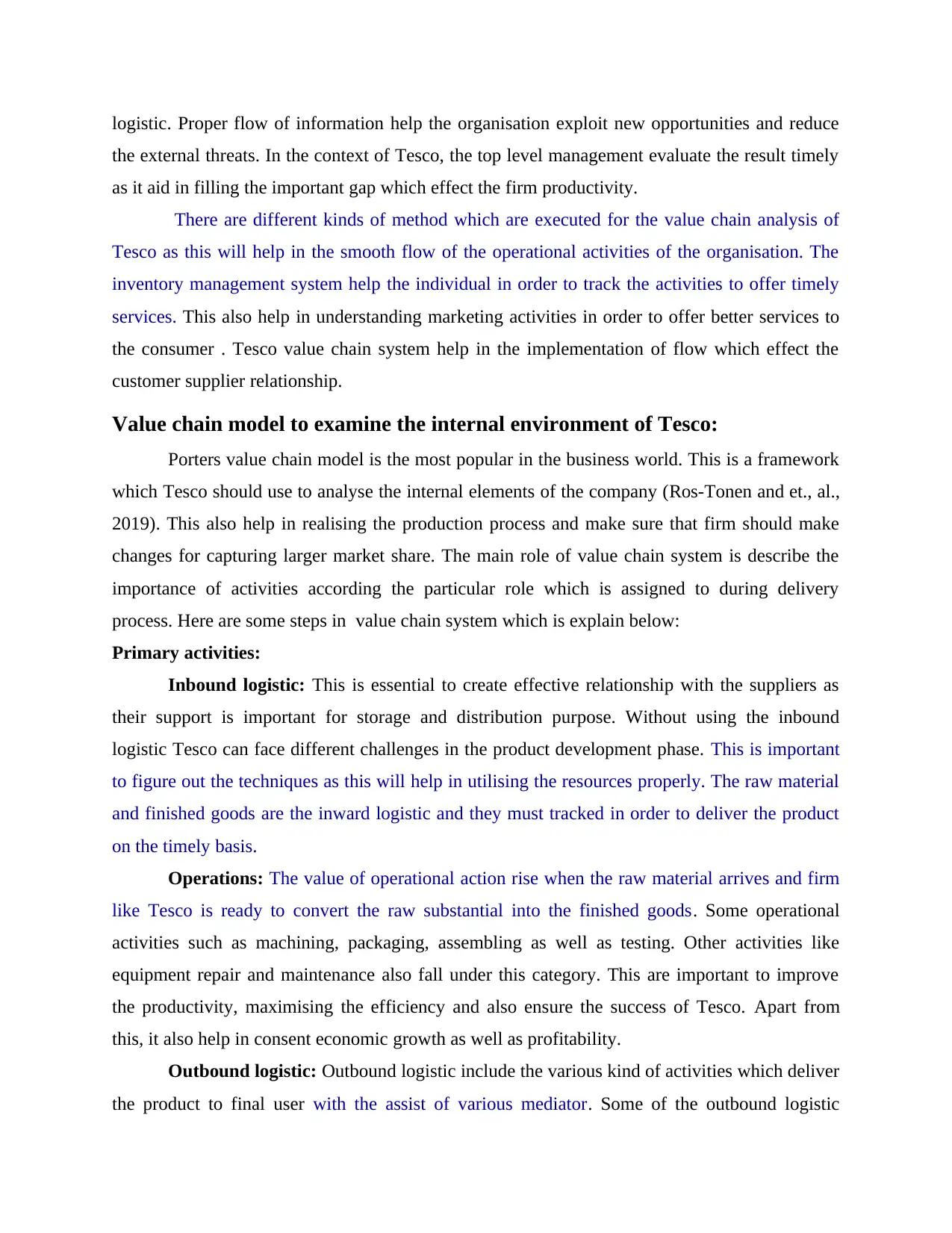
logistic. Proper flow of information help the organisation exploit new opportunities and reduce
the external threats. In the context of Tesco, the top level management evaluate the result timely
as it aid in filling the important gap which effect the firm productivity.
There are different kinds of method which are executed for the value chain analysis of
Tesco as this will help in the smooth flow of the operational activities of the organisation. The
inventory management system help the individual in order to track the activities to offer timely
services. This also help in understanding marketing activities in order to offer better services to
the consumer . Tesco value chain system help in the implementation of flow which effect the
customer supplier relationship.
Value chain model to examine the internal environment of Tesco:
Porters value chain model is the most popular in the business world. This is a framework
which Tesco should use to analyse the internal elements of the company (Ros-Tonen and et., al.,
2019). This also help in realising the production process and make sure that firm should make
changes for capturing larger market share. The main role of value chain system is describe the
importance of activities according the particular role which is assigned to during delivery
process. Here are some steps in value chain system which is explain below:
Primary activities:
Inbound logistic: This is essential to create effective relationship with the suppliers as
their support is important for storage and distribution purpose. Without using the inbound
logistic Tesco can face different challenges in the product development phase. This is important
to figure out the techniques as this will help in utilising the resources properly. The raw material
and finished goods are the inward logistic and they must tracked in order to deliver the product
on the timely basis.
Operations: The value of operational action rise when the raw material arrives and firm
like Tesco is ready to convert the raw substantial into the finished goods. Some operational
activities such as machining, packaging, assembling as well as testing. Other activities like
equipment repair and maintenance also fall under this category. This are important to improve
the productivity, maximising the efficiency and also ensure the success of Tesco. Apart from
this, it also help in consent economic growth as well as profitability.
Outbound logistic: Outbound logistic include the various kind of activities which deliver
the product to final user with the assist of various mediator. Some of the outbound logistic
the external threats. In the context of Tesco, the top level management evaluate the result timely
as it aid in filling the important gap which effect the firm productivity.
There are different kinds of method which are executed for the value chain analysis of
Tesco as this will help in the smooth flow of the operational activities of the organisation. The
inventory management system help the individual in order to track the activities to offer timely
services. This also help in understanding marketing activities in order to offer better services to
the consumer . Tesco value chain system help in the implementation of flow which effect the
customer supplier relationship.
Value chain model to examine the internal environment of Tesco:
Porters value chain model is the most popular in the business world. This is a framework
which Tesco should use to analyse the internal elements of the company (Ros-Tonen and et., al.,
2019). This also help in realising the production process and make sure that firm should make
changes for capturing larger market share. The main role of value chain system is describe the
importance of activities according the particular role which is assigned to during delivery
process. Here are some steps in value chain system which is explain below:
Primary activities:
Inbound logistic: This is essential to create effective relationship with the suppliers as
their support is important for storage and distribution purpose. Without using the inbound
logistic Tesco can face different challenges in the product development phase. This is important
to figure out the techniques as this will help in utilising the resources properly. The raw material
and finished goods are the inward logistic and they must tracked in order to deliver the product
on the timely basis.
Operations: The value of operational action rise when the raw material arrives and firm
like Tesco is ready to convert the raw substantial into the finished goods. Some operational
activities such as machining, packaging, assembling as well as testing. Other activities like
equipment repair and maintenance also fall under this category. This are important to improve
the productivity, maximising the efficiency and also ensure the success of Tesco. Apart from
this, it also help in consent economic growth as well as profitability.
Outbound logistic: Outbound logistic include the various kind of activities which deliver
the product to final user with the assist of various mediator. Some of the outbound logistic
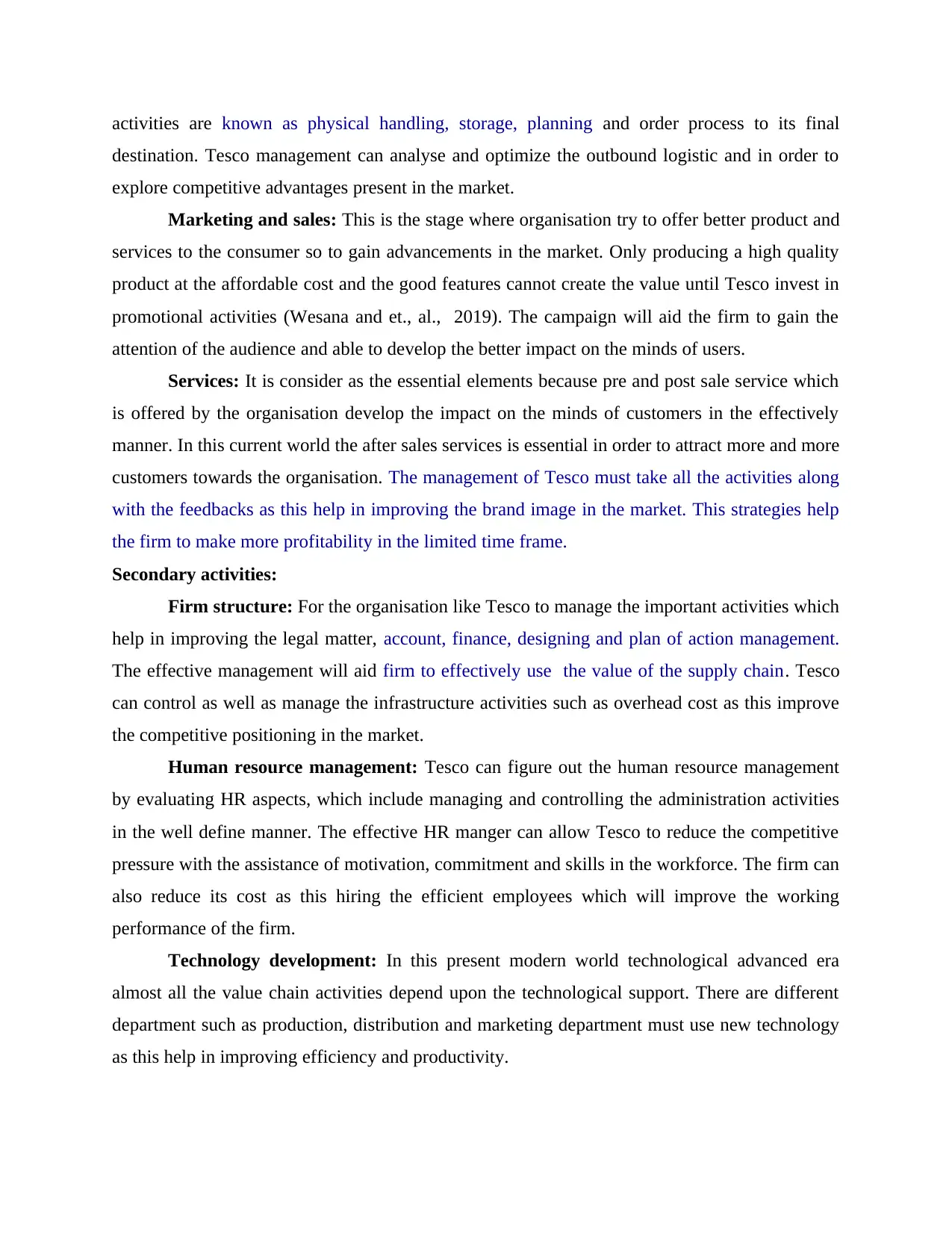
activities are known as physical handling, storage, planning and order process to its final
destination. Tesco management can analyse and optimize the outbound logistic and in order to
explore competitive advantages present in the market.
Marketing and sales: This is the stage where organisation try to offer better product and
services to the consumer so to gain advancements in the market. Only producing a high quality
product at the affordable cost and the good features cannot create the value until Tesco invest in
promotional activities (Wesana and et., al., 2019). The campaign will aid the firm to gain the
attention of the audience and able to develop the better impact on the minds of users.
Services: It is consider as the essential elements because pre and post sale service which
is offered by the organisation develop the impact on the minds of customers in the effectively
manner. In this current world the after sales services is essential in order to attract more and more
customers towards the organisation. The management of Tesco must take all the activities along
with the feedbacks as this help in improving the brand image in the market. This strategies help
the firm to make more profitability in the limited time frame.
Secondary activities:
Firm structure: For the organisation like Tesco to manage the important activities which
help in improving the legal matter, account, finance, designing and plan of action management.
The effective management will aid firm to effectively use the value of the supply chain. Tesco
can control as well as manage the infrastructure activities such as overhead cost as this improve
the competitive positioning in the market.
Human resource management: Tesco can figure out the human resource management
by evaluating HR aspects, which include managing and controlling the administration activities
in the well define manner. The effective HR manger can allow Tesco to reduce the competitive
pressure with the assistance of motivation, commitment and skills in the workforce. The firm can
also reduce its cost as this hiring the efficient employees which will improve the working
performance of the firm.
Technology development: In this present modern world technological advanced era
almost all the value chain activities depend upon the technological support. There are different
department such as production, distribution and marketing department must use new technology
as this help in improving efficiency and productivity.
destination. Tesco management can analyse and optimize the outbound logistic and in order to
explore competitive advantages present in the market.
Marketing and sales: This is the stage where organisation try to offer better product and
services to the consumer so to gain advancements in the market. Only producing a high quality
product at the affordable cost and the good features cannot create the value until Tesco invest in
promotional activities (Wesana and et., al., 2019). The campaign will aid the firm to gain the
attention of the audience and able to develop the better impact on the minds of users.
Services: It is consider as the essential elements because pre and post sale service which
is offered by the organisation develop the impact on the minds of customers in the effectively
manner. In this current world the after sales services is essential in order to attract more and more
customers towards the organisation. The management of Tesco must take all the activities along
with the feedbacks as this help in improving the brand image in the market. This strategies help
the firm to make more profitability in the limited time frame.
Secondary activities:
Firm structure: For the organisation like Tesco to manage the important activities which
help in improving the legal matter, account, finance, designing and plan of action management.
The effective management will aid firm to effectively use the value of the supply chain. Tesco
can control as well as manage the infrastructure activities such as overhead cost as this improve
the competitive positioning in the market.
Human resource management: Tesco can figure out the human resource management
by evaluating HR aspects, which include managing and controlling the administration activities
in the well define manner. The effective HR manger can allow Tesco to reduce the competitive
pressure with the assistance of motivation, commitment and skills in the workforce. The firm can
also reduce its cost as this hiring the efficient employees which will improve the working
performance of the firm.
Technology development: In this present modern world technological advanced era
almost all the value chain activities depend upon the technological support. There are different
department such as production, distribution and marketing department must use new technology
as this help in improving efficiency and productivity.
⊘ This is a preview!⊘
Do you want full access?
Subscribe today to unlock all pages.

Trusted by 1+ million students worldwide
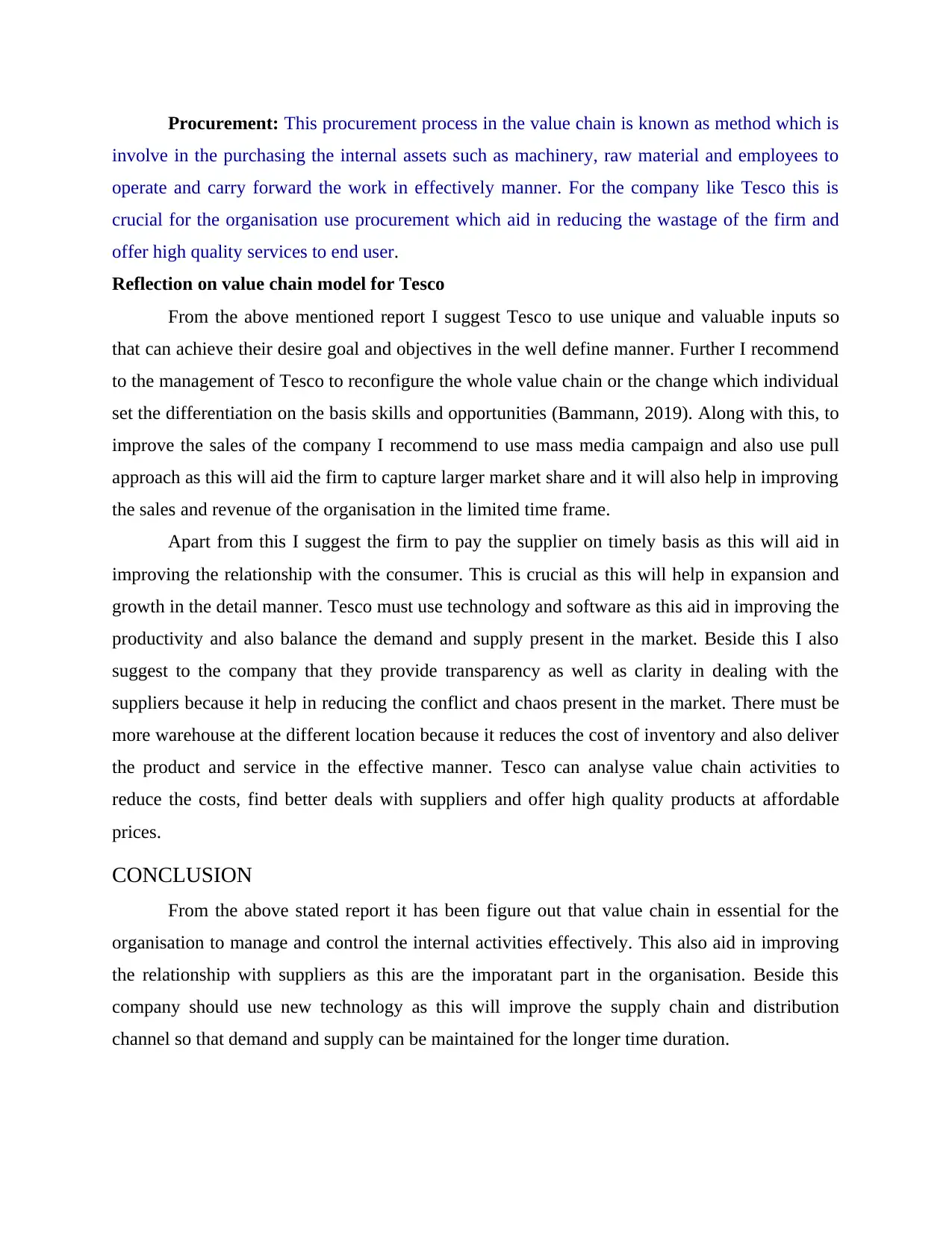
Procurement: This procurement process in the value chain is known as method which is
involve in the purchasing the internal assets such as machinery, raw material and employees to
operate and carry forward the work in effectively manner. For the company like Tesco this is
crucial for the organisation use procurement which aid in reducing the wastage of the firm and
offer high quality services to end user.
Reflection on value chain model for Tesco
From the above mentioned report I suggest Tesco to use unique and valuable inputs so
that can achieve their desire goal and objectives in the well define manner. Further I recommend
to the management of Tesco to reconfigure the whole value chain or the change which individual
set the differentiation on the basis skills and opportunities (Bammann, 2019). Along with this, to
improve the sales of the company I recommend to use mass media campaign and also use pull
approach as this will aid the firm to capture larger market share and it will also help in improving
the sales and revenue of the organisation in the limited time frame.
Apart from this I suggest the firm to pay the supplier on timely basis as this will aid in
improving the relationship with the consumer. This is crucial as this will help in expansion and
growth in the detail manner. Tesco must use technology and software as this aid in improving the
productivity and also balance the demand and supply present in the market. Beside this I also
suggest to the company that they provide transparency as well as clarity in dealing with the
suppliers because it help in reducing the conflict and chaos present in the market. There must be
more warehouse at the different location because it reduces the cost of inventory and also deliver
the product and service in the effective manner. Tesco can analyse value chain activities to
reduce the costs, find better deals with suppliers and offer high quality products at affordable
prices.
CONCLUSION
From the above stated report it has been figure out that value chain in essential for the
organisation to manage and control the internal activities effectively. This also aid in improving
the relationship with suppliers as this are the imporatant part in the organisation. Beside this
company should use new technology as this will improve the supply chain and distribution
channel so that demand and supply can be maintained for the longer time duration.
involve in the purchasing the internal assets such as machinery, raw material and employees to
operate and carry forward the work in effectively manner. For the company like Tesco this is
crucial for the organisation use procurement which aid in reducing the wastage of the firm and
offer high quality services to end user.
Reflection on value chain model for Tesco
From the above mentioned report I suggest Tesco to use unique and valuable inputs so
that can achieve their desire goal and objectives in the well define manner. Further I recommend
to the management of Tesco to reconfigure the whole value chain or the change which individual
set the differentiation on the basis skills and opportunities (Bammann, 2019). Along with this, to
improve the sales of the company I recommend to use mass media campaign and also use pull
approach as this will aid the firm to capture larger market share and it will also help in improving
the sales and revenue of the organisation in the limited time frame.
Apart from this I suggest the firm to pay the supplier on timely basis as this will aid in
improving the relationship with the consumer. This is crucial as this will help in expansion and
growth in the detail manner. Tesco must use technology and software as this aid in improving the
productivity and also balance the demand and supply present in the market. Beside this I also
suggest to the company that they provide transparency as well as clarity in dealing with the
suppliers because it help in reducing the conflict and chaos present in the market. There must be
more warehouse at the different location because it reduces the cost of inventory and also deliver
the product and service in the effective manner. Tesco can analyse value chain activities to
reduce the costs, find better deals with suppliers and offer high quality products at affordable
prices.
CONCLUSION
From the above stated report it has been figure out that value chain in essential for the
organisation to manage and control the internal activities effectively. This also aid in improving
the relationship with suppliers as this are the imporatant part in the organisation. Beside this
company should use new technology as this will improve the supply chain and distribution
channel so that demand and supply can be maintained for the longer time duration.
Paraphrase This Document
Need a fresh take? Get an instant paraphrase of this document with our AI Paraphraser
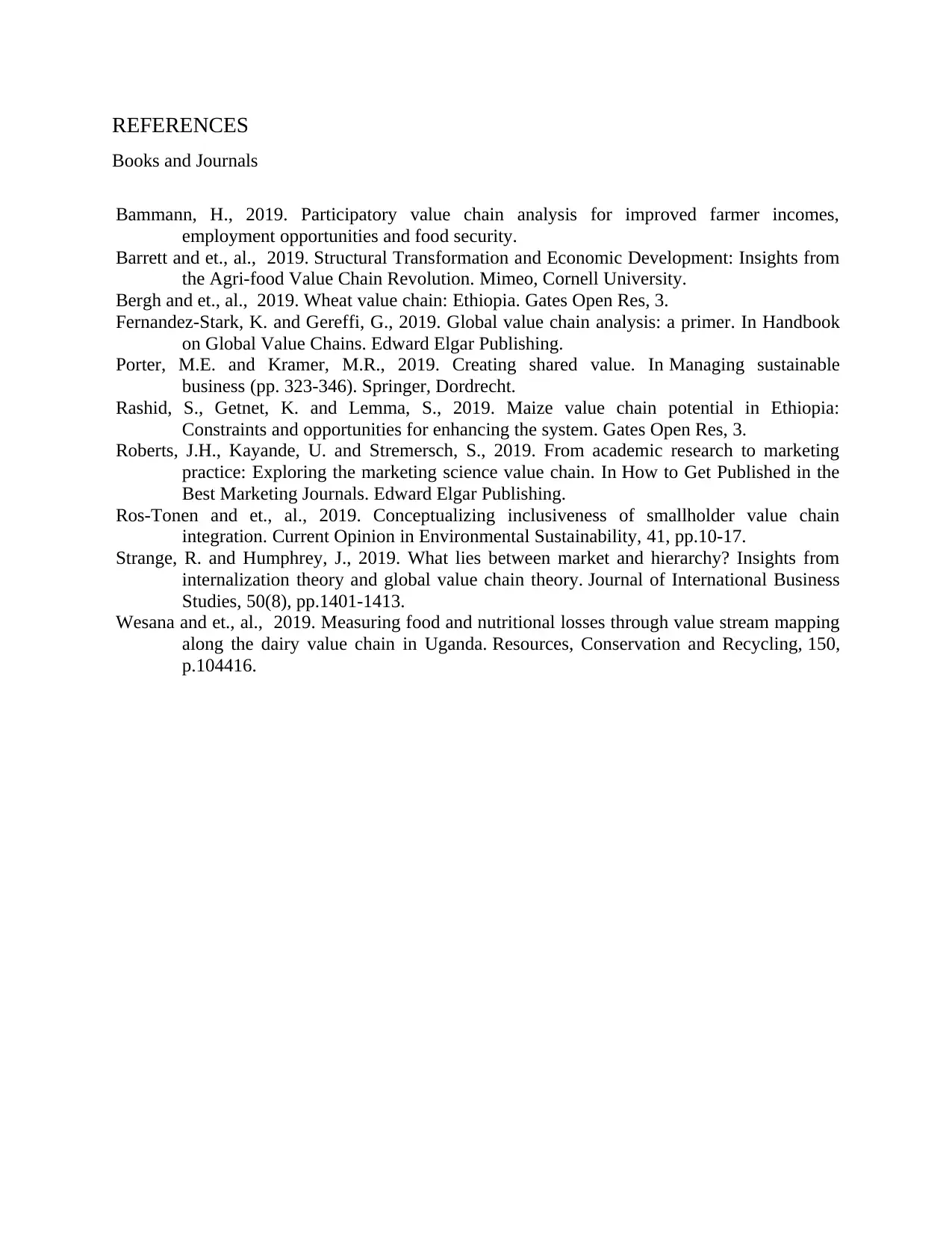
REFERENCES
Books and Journals
Bammann, H., 2019. Participatory value chain analysis for improved farmer incomes,
employment opportunities and food security.
Barrett and et., al., 2019. Structural Transformation and Economic Development: Insights from
the Agri-food Value Chain Revolution. Mimeo, Cornell University.
Bergh and et., al., 2019. Wheat value chain: Ethiopia. Gates Open Res, 3.
Fernandez-Stark, K. and Gereffi, G., 2019. Global value chain analysis: a primer. In Handbook
on Global Value Chains. Edward Elgar Publishing.
Porter, M.E. and Kramer, M.R., 2019. Creating shared value. In Managing sustainable
business (pp. 323-346). Springer, Dordrecht.
Rashid, S., Getnet, K. and Lemma, S., 2019. Maize value chain potential in Ethiopia:
Constraints and opportunities for enhancing the system. Gates Open Res, 3.
Roberts, J.H., Kayande, U. and Stremersch, S., 2019. From academic research to marketing
practice: Exploring the marketing science value chain. In How to Get Published in the
Best Marketing Journals. Edward Elgar Publishing.
Ros-Tonen and et., al., 2019. Conceptualizing inclusiveness of smallholder value chain
integration. Current Opinion in Environmental Sustainability, 41, pp.10-17.
Strange, R. and Humphrey, J., 2019. What lies between market and hierarchy? Insights from
internalization theory and global value chain theory. Journal of International Business
Studies, 50(8), pp.1401-1413.
Wesana and et., al., 2019. Measuring food and nutritional losses through value stream mapping
along the dairy value chain in Uganda. Resources, Conservation and Recycling, 150,
p.104416.
Books and Journals
Bammann, H., 2019. Participatory value chain analysis for improved farmer incomes,
employment opportunities and food security.
Barrett and et., al., 2019. Structural Transformation and Economic Development: Insights from
the Agri-food Value Chain Revolution. Mimeo, Cornell University.
Bergh and et., al., 2019. Wheat value chain: Ethiopia. Gates Open Res, 3.
Fernandez-Stark, K. and Gereffi, G., 2019. Global value chain analysis: a primer. In Handbook
on Global Value Chains. Edward Elgar Publishing.
Porter, M.E. and Kramer, M.R., 2019. Creating shared value. In Managing sustainable
business (pp. 323-346). Springer, Dordrecht.
Rashid, S., Getnet, K. and Lemma, S., 2019. Maize value chain potential in Ethiopia:
Constraints and opportunities for enhancing the system. Gates Open Res, 3.
Roberts, J.H., Kayande, U. and Stremersch, S., 2019. From academic research to marketing
practice: Exploring the marketing science value chain. In How to Get Published in the
Best Marketing Journals. Edward Elgar Publishing.
Ros-Tonen and et., al., 2019. Conceptualizing inclusiveness of smallholder value chain
integration. Current Opinion in Environmental Sustainability, 41, pp.10-17.
Strange, R. and Humphrey, J., 2019. What lies between market and hierarchy? Insights from
internalization theory and global value chain theory. Journal of International Business
Studies, 50(8), pp.1401-1413.
Wesana and et., al., 2019. Measuring food and nutritional losses through value stream mapping
along the dairy value chain in Uganda. Resources, Conservation and Recycling, 150,
p.104416.
1 out of 8
Related Documents
Your All-in-One AI-Powered Toolkit for Academic Success.
+13062052269
info@desklib.com
Available 24*7 on WhatsApp / Email
![[object Object]](/_next/static/media/star-bottom.7253800d.svg)
Unlock your academic potential
Copyright © 2020–2025 A2Z Services. All Rights Reserved. Developed and managed by ZUCOL.





